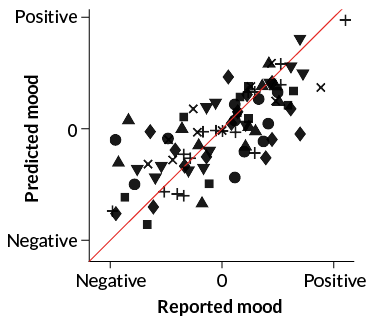Maryam Shanechi designs machines to read minds
Her work could one day help patients with paralysis and psychiatric disorders

Maryam Shanechi creates computer systems that use brainpower to move machines, and may one day regulate mood.
USC Viterbi
- More than 2 years ago
Mind reading may sound like a sci-fi dream, but it’s Maryam Shanechi’s day job.
This neural engineer doesn’t need mind melds or magic spells to tap into brain activity. Rather, Shanechi, 38, develops computer algorithms that translate electrical blips emitted by brain cells into machine commands. Shanechi has designed and tested systems that harness neural firings to control computer cursors or administer just the right amount of anesthetic.
Now, Shanechi is forging into a new frontier — mind control. She’s on a mission to create brain-machine interfaces that not only eavesdrop on cells, but also stimulate them to alter mood. This mental manipulation may one day offer a better treatment to millions of patients with psychiatric disorders, like anxiety or depression, who don’t respond to existing therapies.
Shanechi arrived on the neuroscience scene almost by accident. In graduate school, she was studying techniques to decode wireless communication signals. But one rainy morning in her MIT dorm, Shanechi stumbled across a video of a computer algorithm that could predict a rat’s location in a maze based solely on the rodent’s brain activity. Despite knowing nothing about neuroscience, Shanechi thought, “How cool would it be if I could decode brain signals?”
Ziv Williams, who worked with Shanechi when she was in graduate school, recalls how seamlessly she adapted to neuroscience research methods, like working with live animals. With degrees in computer science and electrical engineering, Shanechi brings skills to brain-machine interfaces that “neuroscientists who come at it from a biological perspective do not have,” says Williams, a neurosurgeon at Harvard University and Massachusetts General Hospital in Boston.
Engineers have been developing brain-machine interfaces to allow paralyzed patients to move computer cursors or robotic limbs for two decades. But these thought-controlled devices are still largely limited to research settings.
Shanechi designed her first mind-reading algorithm to figure out how a monkey wanted to move a computer cursor, based on signals collected by electrodes implanted in the monkey’s premotor cortex. Whereas other machinery had processed intended motions one by one, Shanechi’s system anticipated an entire series of movements for finer control. The work was reported in 2012 in Nature Neuroscience. Seeing her algorithm correctly predict a monkey’s movements for the first time was “the most exciting moment in my whole career,” Shanechi says.
Mind control
A monkey used two different brain-machine interfaces to move a computer cursor from one gray dot to another while avoiding a red oval (cursor tracks shown in blue and orange). The monkey showed higher precision when using the system that decoded intended movement at millisecond timescales (left) than when using a traditional brain-machine interface (right), which registered intended movement every 100 milliseconds.

When something sparks Shanechi’s interest, “she goes all the way,” says her father, Hassan. He still remembers an English class Shanechi took after the family moved from Iran to Canada, when she was a teenager. Shanechi wanted to take an advanced literature course but was told her English wasn’t good enough. Undeterred, she enrolled in a class for students learning English as a second language then reapplied for the advanced course a few months later. She was admitted to the class and performed so well that she was exempt from the final exam.
Now at the University of Southern California in Los Angeles, Shanechi devises new algorithms to more seamlessly put thoughts into motion. In Nature Communications in 2017, her team reported a brain-machine interface that tracks individual nerve cell firings to decipher intended movement at millisecond timescales. That was a major upgrade from other systems that decode movements based on the number of nerve cell firings in 50- to 100-millisecond intervals. Monkeys using the new scheme moved a cursor much more quickly and deftly.
Tailoring a brain-machine interface to monitor individual nerve cell firings, rather than collective neural activity, is the kind of design rigor that makes Shanechi stand out, says Emery Brown, a statistician and anesthesiologist at MIT and Mass General and Shanechi’s graduate school adviser. She takes no shortcuts and “that’s where I think she has excelled.”
Reading moods
By studying people’s brain activity and mood reports over several days, a computer algorithm learned to use nerve cell firings to predict state of mind. Each icon shape represents one of seven people. The closer an icon is to the diagonal line, the better the algorithm’s forecast matched the person’s self-reported mood.
Mood prediction versus self‑reports

Source: O.G. Sani et al/Nature Biotechnology 2018
Shanechi is now laying the groundwork for a new generation of devices that would stimulate the brain to coax patients with psychiatric disorders into healthier headspaces. Unlike typical deep-brain stimulation that has to be manually adjusted, these devices would monitor a patient’s symptoms and adjust stimulation automatically.
Deciphering mood is harder than interpreting movement, Shanechi says, because the nerve cells responsible for mood span several brain regions, and scientists don’t fully understand how those far-flung nerve cells coordinate.
Last year, Shanechi’s team demonstrated that a computer algorithm can use a person’s brain activity to judge how good or bad the person feels. The researchers tested the system, reported in Nature Biotechnology, in people who already had implanted electrodes for epilepsy treatment. Next, Shanechi wants to see how these results hold up for patients diagnosed with depression.
To improve mood, a device also needs to know how different kinds of electrical stimulation tickle different brain cells. So Shanechi is working on a system, reported in the December 2018 Journal of Neural Engineering, that feeds a train of electrical pulses into the brain and catalogs how nerve cells react to those pulses.
Despite the sci-fi–sounding nature of her work, Shanechi’s motivation is the real-world impact her technology could have. “What I really enjoy,” she says, “is to see a mathematical concept making its way toward making a difference in people’s lives.”







